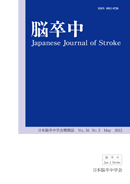All issues

Volume 29 (2007)
- Issue 6 Pages 669-
- Issue 5 Pages 617-
- Issue 4 Pages 493-
- Issue 3 Pages 451-
- Issue 1 Pages 1-
Volume 29, Issue 6
Displaying 51-54 of 54 articles from this issue
Joint Symposium II
-
Hisashi Kai, Nobuhiro Tahara, Tsutomu Imaizumi2007 Volume 29 Issue 6 Pages 819-823
Published: November 25, 2007
Released on J-STAGE: February 06, 2009
JOURNAL FREE ACCESSAtherosclerosis is widely accepted as a chronic inflammatory disorder. However it was impossible to visualize non-invasively inflammation of individual plaques. We have reported that 18 [F]-fluorodeoxyglucose (FDG) uptake, namely inflammation, can be detected quantitatively in carotid or aortic plaques using FDG-positron emission tomography (PET) imaging co-registered with computed tomography (CT) (FDG-PET/CT). Of patients who had the ultrasound-proven carotid atherosclerosis without recent cerebrovascular events, approximately 30% showed FDG uptake in the carotid artery by assessing PET/CT imaging. In patients who underwent FDG-PET/CT imaging for cancer screening and had no recent cerebrovascular events, the intensity of carotid inflammation was well associated with the components of the metabolic syndrome (positively with body circumference and HOMA-RI; negatively with HDL cholesterol level), as well as mean carotid intima-media complex thickness and high-sensitivity CRP level. Moreover, 3-month simvastatin treatment attenuated inflammation of carotid and aortic plaques. The reduction in inflammation was correlated with the increase in HDL cholesterol, but not with the decrease in LDL cholesterol. Accordingly, this non-invasive, metabolic imaging modality would aid in the risk stratification and the selection of appropriate therapy of patients at risk of atherosclerotic diseases.View full abstractDownload PDF (1578K) -
Masaaki Uno, Masafumi Harada, Naomi Morita, Kyoko Nishi, Shunji Matsub ...2007 Volume 29 Issue 6 Pages 824-830
Published: November 25, 2007
Released on J-STAGE: February 06, 2009
JOURNAL FREE ACCESSWe report usefulness of 3 tesla MRI and new ischemic findings on gradient echo-type T2*-weighted images (T2*-WI) in patients with acute ischemic stroke We defined two ischemic findings regarding the vessels (cortical vessel enlargement sign; hypointensity of the cortical vessels and brush sign; hypointensity of the deep white matter vessels) and a decreased intensity in the ischemic parenchyma (tissue ischemic sign) on the T2*-WI. These ischemic findings were compared with the hypoperfused area detected by the FAIR images and the ROI comparison between the hypoperfusion on the FAIR imaging and the “tissue ischemic sign” on the T2*-WI was conducted by calculating the asymmetry ratios. This cortical vessel enlargement sign was seen in all patients with ICA or MCA occlusion. The area of the vessel ischemic signs was almost the same or less than the hypoperfused area shown by the PWI images. In patients who showed tissue ischemic sign, the ROI measurement demonstrated more hypoperfusion by PWI than in the sign (-) group. 3T MRI is therefore useful to evaluate ischemic conditions in acute stroke patients.View full abstractDownload PDF (2867K) -
[in Japanese]2007 Volume 29 Issue 6 Pages 831
Published: November 25, 2007
Released on J-STAGE: February 06, 2009
JOURNAL FREE ACCESSDownload PDF (53K) -
[in Japanese], [in Japanese], [in Japanese], [in Japanese], [in Japane ...2007 Volume 29 Issue 6 Pages 832
Published: November 25, 2007
Released on J-STAGE: February 06, 2009
JOURNAL FREE ACCESSDownload PDF (52K)